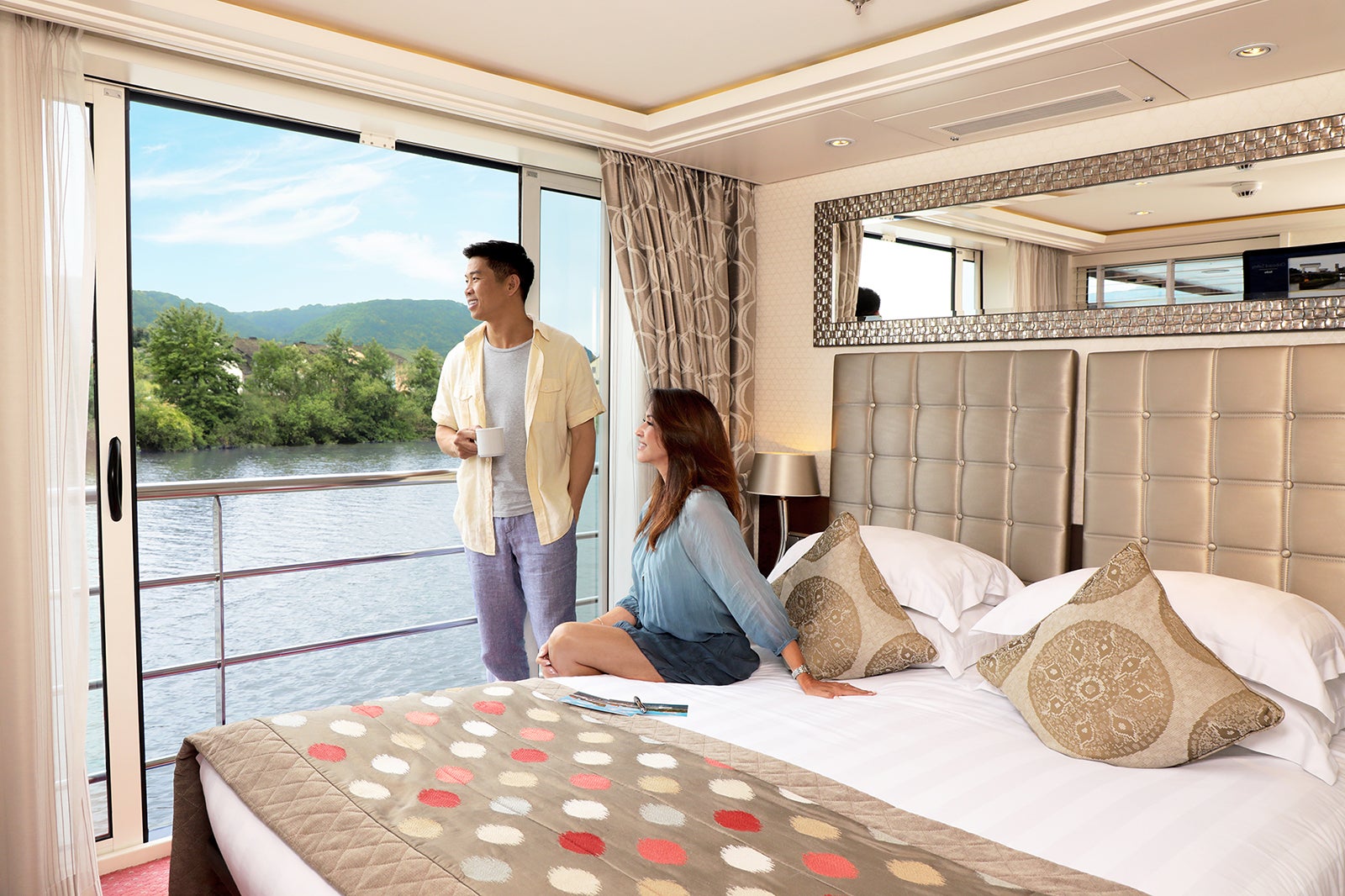You booked your river cruise, and the departure date approaches. Now you’re panicking about what to pack.
You want to pack light, given you won’t have much space in your cabin to store bulky suitcases. However, you also want to be prepared with the right clothing and gear for changeable weather on the river, visits to religious sites and the many walking and cycling tours you plan to do in port. How will you fit everything in a carry-on?
It seems like a lot, but there’s no need to feel overwhelmed about packing for a river cruise. I’ve been on more than 125 cruises, including many river sailings.
Below are my top packing tips and a river cruise packing list for a river cruise in Europe, the United States, Asia or Africa. Follow these tips to take the stress out of your pre-trip prep.
For cruise news, reviews and tips, sign up for TPG’s cruise newsletter.
What to pack on a river cruise
The first thing to understand is that where you cruise will dictate what you pack. The Nile River in July will be quite different than the Rhine in November, and you’ll need different clothing and gear.
However, river cruises are often during warmer times of the year in places that may not see ice and snow. Typically, heavy outwear isn’t needed. (At least not much of it — I was on a Tennessee River cruise in early November, and it snowed for several hours one day!)
Here’s what to pack to get maximum use out of minimal luggage.
Related: Booking your first river cruise? Here’s what you need to know.
Sign up for our daily newsletter
Lightweight layers
The key to river cruise packing is layering.
On some rivers in Asia and Africa, such as Egypt’s Nile River, it can get extremely hot during the day — we’re talking 90-plus degrees Fahrenheit — but cool in the evenings.
Late-summer weather in Europe can also change frequently. During a river cruise in the Netherlands in early September, some days were hot and others rainy and chilly. For all these destinations, you’ll want to be able to peel layers off and put them on again.
Layers are also convenient should you need to cover up your shoulders and legs to enter religious buildings like temples, monasteries and cathedrals.
Light scarves are useful for covering shoulders in religious places and covering your head and face when it’s hot or dusty. Colorful scarves can also be a great accent piece for a dinner outfit on board.
For the best layering, think about packing several thin long- and short-sleeved T-shirts, as well as a jacket, such as an outdoorsy zip-up jacket or vest from Patagonia. I often bring a dark denim jacket for layering. It’s warm and looks stylish when worn over T-shirts and accented with scarves.
Related: Cruise packing list: The ultimate guide to what to pack for a cruise
Casual clothes for day and night
River cruises involve full days of touring on land, so casual and comfortable clothing is key.
Cargo pants or shorts are a great idea on a river cruise, especially for the popular cycling and walking excursions. You can stash your phone, a thin wallet and even sunscreen or bug spray in the large pockets, leaving your hands free to navigate a bicycle or walking sticks.
It may sound counterintuitive, but for very hot places in Southeast Asia, India, Egypt, Amazon region and Europe in August, it’s best to wear long sleeves when touring, even in the hottest summer months. This will protect you from sunburn.
Prepare for various temperatures and pack lightweight breathable fabrics. I prefer thin cotton tops, while my husband likes the moisture-wicking shirts from Arcteryx and similar brands. Both kinds take up little suitcase space and dry quickly when hand-washed.
Some of the newer riverboats from lines like AmaWaterways and Scenic have small pools on deck, so pack a swimsuit if you’d like to take a dip.
Related: Best river cruise lines around the world
When it comes to dining, river cruises are generally casual. You can even have dinner wearing what you wore on the afternoon’s excursions — within reason. I wouldn’t wear cargo shorts to dinner, but I’d wear jeans.
That said, especially on Europe river cruises, most folks like to wear a nicer shirt or top for dinner layered with a nice scarf, vest or a thin easy-to-fold jacket. Passengers on higher-end river cruise lines in Europe (such as Uniworld and AmaWaterways) tend to dress up in the evenings more than guests on more affordable cruises.
No river cruise line will expect you to bring suit jackets or sparkly clothes. However, I’ve seen women in cocktail dresses and men in sport coats on Europe and Mississippi river cruises.
Related: What to wear on a cruise: Cruise attire and cruise line dress codes
Footwear
Bring a pair of sturdy sneakers or light trekking shoes for excursions that may require long city walks in Europe and the U.S. or hiking on dirt roads or rocky paths in more rural areas in India, Laos, Cambodia and the Amazon. Alpine-style hiking boots are not necessary.
For Southeast Asia and India river cruises, bring a comfortable slip-on shoe, like a pair of Crocs, that are easy to get off and on because you’ll have to remove shoes before going into temples. You’re usually allowed to wear socks, so bring multiple lightweight ankle or no-show socks you can easily wash in your cabin sink when they get dusty from walking on dirt roads.
Ideally, bring a third pair of shoes to wear inside your cabin and around the boat’s interior, such as sandals, boat shoes, flats or whatever casual lightweight shoe you prefer. I never travel without my hot pink Birkenstocks; they’re cute and versatile, without or with socks.
Accessories and travel gear
Clothing isn’t the only thing you’ll need to pack for your river cruise. The No.1 accessory you should pack is a lightweight backpack, fanny pack or sling bag that is easy to carry on walking or biking tours or on more active treks.
Riverboats that offer the use of bicycles should provide helmets, but the options may not always fit the way you like. If you plan on cycling a lot (we cycled daily, sometimes twice a day on a recent AmaWaterways Netherlands and Belgium river cruise), consider bringing your own. The helmet may take up valuable real estate in your luggage, but it’s a must if you’re fussy about what you put on your head.
I like to wear a thin baseball cap under the helmets I borrow from cruise lines. The visor of the cap keeps the sun or rain away from your eyes. Also, if you’re uncomfortable wearing a previously-worn helmet, a ballcap can be a barrier to keep you from touching the hat directly. You can also tie a bandana on your head before putting on the borrowed helmet.
Ask your cruise line if it gifts passengers a reusable aluminum-style water bottle to fill up on board and use during shore excursions. If yours doesn’t, bring your own lightweight refillable water bottle as an eco-friendly practice to cut down on single-use plastic waste.
Related: 20 must-have cruise items — including a roll of duct tape
If river cruising in Southeast Asia, India, South America or Africa, bring a small bag of your preferred medicines because you might not find the brands or names you’re used to in port. Also, bring your pain reliever of choice, and anti-diarrhea medicine, just in case.
Also, carry a small container of insect repellent, for excursions and your room, on cruises in tropical places where mosquitos and other bugs are prevalent.
Since evening entertainment on a river cruise is minimal — typically a bit of music after dinner or nothing at all — consider packing your own evening entertainment.
Bring books, an e-reader or a tablet, but make sure to download books and movies to your device before your trip. Wi-Fi can be weak on riverboats anywhere in the world, so you may not have a signal to read the newspaper in real-time or stream the latest episode of your favorite show.
Tips for river cruise packing
River cruise boat cabins are often on the small side compared to cabins on big cruise ships, so you don’t want to over-pack.
Riverboat cabins are also not as uniform as those on ocean-going ships. European fleets may be more similar, but lines in North America and Asia can have quirky, one-of-a-kind ships. Don’t assume you’ll have as much room on one line as you did on another.
Riverboats may not provide much (or any) space under the beds for bulky suitcases, and closets (if there are any) are compact, so small suitcases or soft duffels are ideal.
There are exceptions, such as the high-end riverboats in Europe from lines like Uniworld and AmaWaterways; larger riverboats like the 417-passenger American Queen on the Mississippi River; and luxury lines like Aqua Expeditions cruising in Asia and the Amazon. These ships offer more storage space in generally larger cabins.
Related: Cruise ship packing mistakes you want to avoid at all costs
Many riverboats also don’t include self-service laundry rooms (though some deluxe Europe riverboats will). Some don’t have laundry service either. If you want to pack light, bring undergarments and layering tops that dry quickly, so you can wash in the bathroom sink and hang them to dry.
River cruise packing list
With all this in mind, here is a suggested packing list for your river cruise vacation:
- Multiple lightweight tops and T-shirts, including long-sleeved versions for sun protection.
- Bottoms, such as leggings, lightweight cargo pants, jeans, khakis, slacks and skirts.
- Evening wear like casual dresses, slacks and nice shirts.
- Multiple pairs of lightweight underwear and socks.
- A lightweight cotton scarf or sarong.
- A lightweight but warm jacket, cardigan and/or thin fleece for chilly mornings or evenings.
- Sturdy shoes, such as sneakers or simple hiking shoes.
- A comfortable slip-on shoe for visiting religious sites or for evenings on board.
- Light backpack or fanny pack for excursions.
- Water-proof zip-top or small bag for your phone and camera for protection in rainy weather and when aboard small launches used for excursions.
- Local and U.S. currency in small bills for purchasing drinks, snacks and souvenirs and for tipping local guides.
- Reading materials (books and e-readers) and/or a tablet.
- Sunscreen and bug spray.
- Sunglasses.
- Hat.
- Lightweight compact umbrella for both rain and sun protection. (Many river cruise lines provide umbrellas, but they’re often the large non-folding kind that aren’t convenient to carry around all day.)
- Prescriptions and basic medicines.
- Chargers for your electronics, plus a portable charger to ensure your phone is always juiced up on long excursions.
- Multi-prong adaptors so you can use both the North American 100- to 120-volt and European 220- to 240-volt outlets on the river cruise boat. (The newest luxury riverboats may have standard USB charging outlets in the lamps on the bedside tables.)
Bottom line
The key to river cruise packing boils down to two important themes.
First, don’t over-pack or bring giant suitcases that won’t fit in your cabin.
Second, dress for success with lots of lightweight layers. Understand the climate and the activities you’ll experience in your river cruise destination, and you have a recipe for the perfect packing job.
Planning a cruise? Start with these stories:




















Discussion about this post